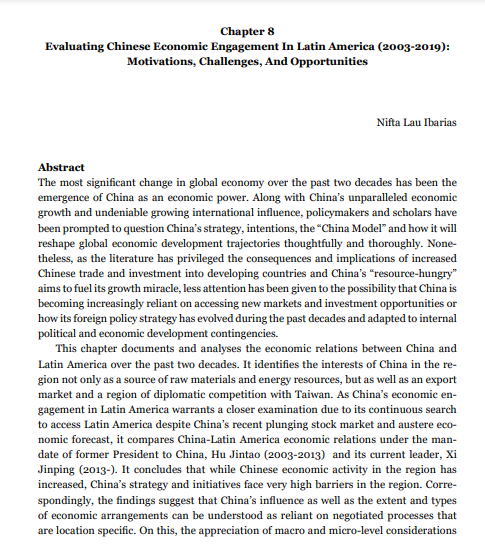Evaluating Chinese Economic Engagement in Latin America (2003-2019): Motivations, Challenges, and Opportunities
Lau, N. (2022). Evaluating Chinese Economic Engagement in Latin America (2003-2019): Motivations, Challenges, and Opportunities https://upittpress.org/books/9780822947851/
The most significant change in global economy over the past two decades has been the emergence of China as an economic power. Along with China’s unparalleled economic growth and undeniable growing international influence, policymakers and scholars have been prompted to question China’s strategy, intentions, the “China Model” and how it will reshape global economic development trajectories thoughtfully and thoroughly. Nonetheless, as the literature has privileged the consequences and implications of increased Chinese trade and investment into developing countries and China’s “resource-hungry” aims to fuel its growth miracle, less attention has been given to the possibility that China is becoming increasingly reliant on accessing new markets and investment opportunities or how its foreign policy strategy has evolved during the past decades and adapted to internal political and economic development contingencies.
This chapter documents and analyses the economic relations between China and Latin America over the past two decades. It identifies the interests of China in the region not only as a source of raw materials and energy resources, but as well as an export market and a region of diplomatic competition with Taiwan. As China’s economic engagement in Latin America warrants a closer examination due to its continuous search to access Latin America despite China’s recent plunging stock market and austere economic forecast, it compares China-Latin America economic relations under the mandate of former President to China, Hu Jintao (2003-2013) and its current leader, Xi Jinping (2013-). It concludes that while Chinese economic activity in the region has increased, China’s strategy and initiatives face very high barriers in the region. Correspondingly, the findings suggest that China’s influence as well as the extent and types of economic arrangements can be understood as reliant on negotiated processes that are location specific. On this, the appreciation of macro and micro-level considerations such as bilateral state-to-state relationship and guanxi, paired with an examination at the internal dynamics of China is essential to develop a more accurate understanding of China-Latin America relations.
